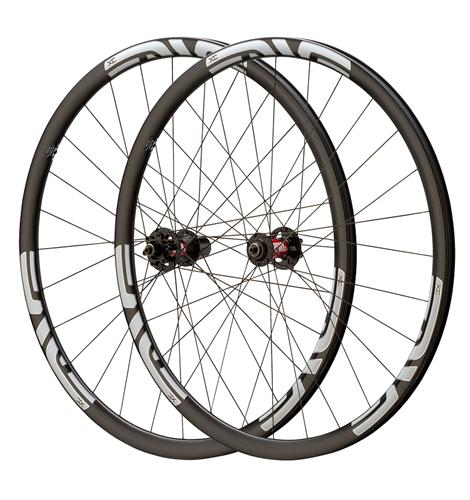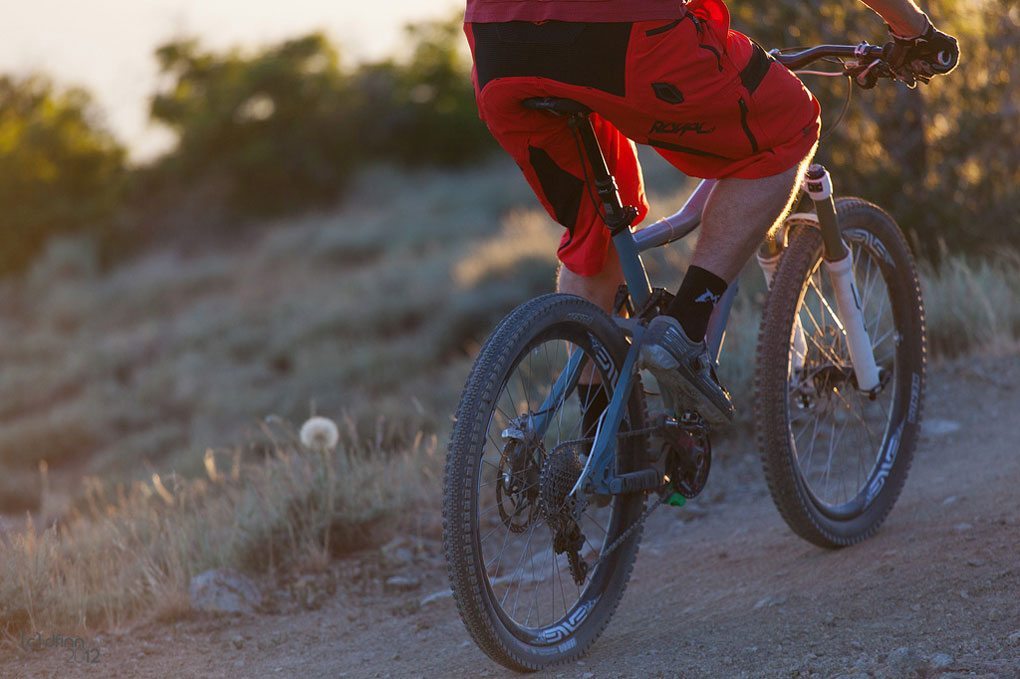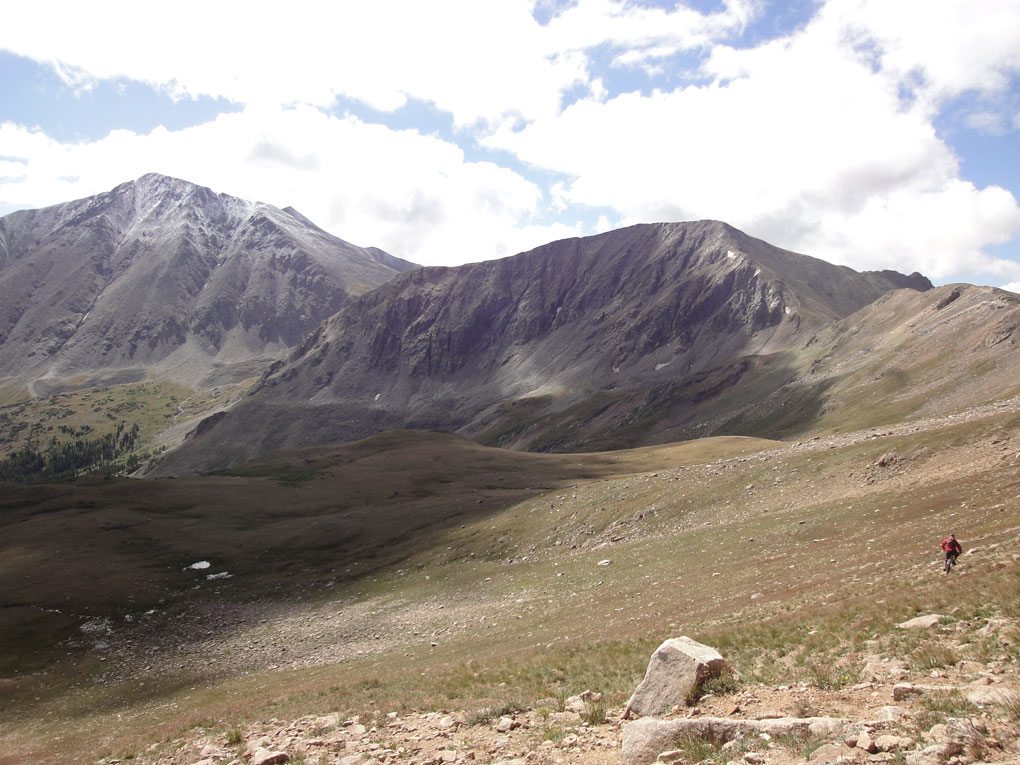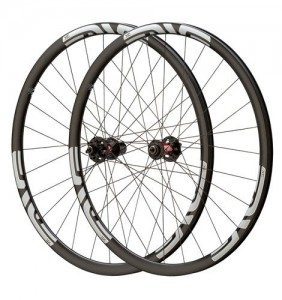Products: ENVE Composites Carbon Rims
 29 XC:
29 XC:
385g each
18.5mm internal width
Wheels built with Hope Pro II EVO hubs with DT Revo Spokes
1,546g total / pair
Tested on Canfield Nimble 9 29’er
 26 AM:
26 AM:
395g each
23mm internal width
Wheels built with Hope Pro II EVO hubs with DT Comp Spokes
1,662g total / pair
Tested on Giant Reign X and Knolly Endorphin Trail Bikes
 26 DH:
26 DH:
470g each
21mm internal width
Wheels built with DT 440 hubs with DT Comp Spokes
1,846g total / pair
Tested on Morewood Makalu DH Bike
Reviewer: 6’2’’, 205 lbs. Expert-class XC, Short-Track, and DH racer.
ENVE rims have managed to carve out a nice little niche in the bike world. They build all of their carbon rims in the U.S.A., in Ogden, Utah. They make all sorts of road, cyclocross, XC, and DH rims, all with the intention of building the absolute top-end World Cup level, race-issue product. With U.S. production and fabulously expensive aerospace-grade materials and build processes comes a correspondingly high price-point: $860 each for the XC to $999 each for the DH.
Carbon has become ubiquitous in road racing and cyclocross racing, and I was very interested to see how carbon really applies to mountain biking. If there are in fact performance gains, how do they manifest themselves, and what does that actually mean in the real world to a competent rider?
I was specifically after several things: how these rims compare to their aluminum rim brethren in an absolute sense (i.e., timed and measured), how they compare in a relative sense (comparatively to the rider), how tangible this was on trail (i.e., does the rim actually offer a better ride, or am I just shaving 5 seconds while out riding by myself with nothing to prove), and how each iteration of the rim (XC, AM, and DH) translated onto the trail.
While the argument typically made for carbon rims is that they save weight, I really look at weight savings as a byproduct. The goal of carbon, in my mind, is to make something that is stiffer without paying a weight penalty. If executed properly, this puts more energy into driving the bike forward, and if that saves a few grams in the process, great. I want to move forward faster with less energy expenditure in a real sense. But I would never want to save weight to the point that it impinges on the ability of my (fairly weak) motor to drive a bicycle forward at a rapid clip. I find too often that light parts sacrifice this key stiffness ingredient, and I end up spending energy on flexing the parts rather than driving the bicycle forward.

I elected to build both my XC and AM rims with Hope Pro II EVO hubs and DT spokes. The Pro II EVO offers a ton of versatility to change out axles to fit QR, 15mm, 20mm, and both QR and 12mm rear standards; they are light (185g front, 285g rear); and have a nice, positive engagement. My normal aluminum rim wheels use these same hubs and spokes, so it kept the test fair.
For the DH rim build, I elected to build the wheels with the stalwart DT 440 hub, which I have upgraded from 18pt engagement to 36pt engagement, and also have upgraded to a titanium cassette body and steel axle. I use this same hub configuration on my DH bike as well.
I have most recently run American Classic and WTB i19 rims on my 29’er, both of which offer a stiffer overall profile than some of the more popular 29’er rims on the market (Stan’s 355, for example). I ran the 29’er bike in two basic arrangements: as a single speed (32 x 20) and in a dual ring (32-44 x 11-34) setup. The 29’er was also setup with a Niner Brand Carbon rigid fork.
I rode the ENVE 29 XC back to back with my aluminum rims, doing numerous hill climbs and intervals all spring to check the differences between the two in regards to speeds, time splits, and gear ratios required to hold a set cadence. I wanted to compare the actual efficiency empirically, both as it related to overall speed and the work required to do so. I also compared the distance required to stop from a given speed. Finally, I took the rims out on a wide variety of trails to get a feel for how this all translated on dirt.
The empirical data is fairly compelling. Compared to the aluminum rims, the ENVE rims were noticeably stiffer and effectively put more of the rider’s energy into acceleration. This translated into being able to drive the bike forward more effectively. The average speeds up a hill were quicker, the deceleration under heavy braking was ~5% faster, I was able to hold a ~10% higher cadence on the single speed going uphill and consistently push one to two gears harder with the same level of energy output while climbing.

These differences were real and tangible. While it was not earth-shattering, nor would it justify a license bump, the performance gain was there and did make a difference on trail. Simply put, the wheels offered the ability to push a little harder gear, and thereby travel a small amount farther with each pedal stroke without any additional energy input by the rider.
I also noted that the carbon rims tended to offer a slightly firmer ride on-trail when mated with a rigid fork—they did not seem to dampen quite as much trail vibration and noise. Though, this is a very minor and totally subjective opinion.
NEXT: 26 AM

